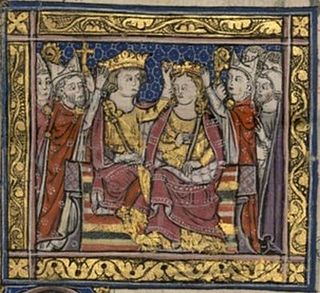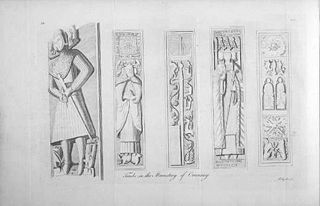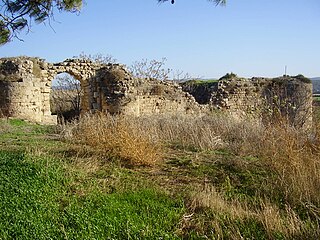Related Research Articles

Maria of Montferrat (1192–1212) was the queen of Jerusalem from 1205 until her death. Her parents were Isabella I and her second husband, Conrad of Montferrat. Maria succeeded her mother under the regency of her half-uncle John of Ibelin. After him the kingdom was ruled on Maria's behalf by her husband, John of Brienne, whom she married in 1210. She died giving birth to her successor, Isabella II.

Earl of Kintore is a title in the Peerage of Scotland. It was created in 1677 for Sir John Keith, third son of William Keith, 6th Hereditary Earl Marischal of Scotland and Chief of Clan Keith. He was made Lord Keith of Inverurie and Keith Hall at the same time, also in the Peerage of Scotland. At the death of William, the 4th Earl, in 1761, the Earldom and Lordship became dormant, as no-one could prove a claim to them. In 1778, it was decided that the Earldom, Lordship and Chieftaincy of Clan should pass to Anthony Adrian Falconer, Lord Falconer of Halkerton, who changed his surname to Keith-Falconer. The Lordship Falconer of Halkerton and the Earldom of Kintore and Lordship Keith of Inverurie and Keith Hall remained united until 1966, when, at the death of the 10th Earl, the Lordship Falconer of Halkerton became dormant.

Viscount of Oxfuird is a title in the Peerage of Scotland. It was created in 1651 for Sir James Makgill, 1st Baronet, along with the subsidiary title of Lord Makgill of Cousland, also in the Peerage of Scotland, with remainder to his "heirs male of tailzie and provision whomsoever". He had already been created a Baronet, of Makgill, in the Baronetage of Nova Scotia on 19 July 1625, with remainder to heirs male whatsoever. The remainder to heirs male whatsoever was a Scottish concept that permitted inheritance by persons not descended from the original grantee, but descended in the male line from male-line ancestors of the grantee. However, on the death of the first Viscount's son, the second Viscount, the Lordship and Viscountcy were assumed by his daughter Christian, as heir of tailzie and provision. Her son Robert Maitland Makgill also voted as Viscount of Oxfuird at the election of Scottish Representative Peers in 1733.
Lord Belhaven and Stenton, of the County of Haddington, is a Lordship of Parliament in the Peerage of Scotland. It was created in 1647 for Sir John Hamilton, 2nd Baronet, with remainder to his heirs male.

Lord Napier, of Merchistoun, is a title in the Peerage of Scotland. It was created in 1627 for Sir Archibald Napier, 1st Baronet. Earlier that year, he already held the Napier Baronetcy, of Merchistoun in the County of Midlothian, created in the Baronetage of Nova Scotia. The titles remained united until 1683, when the Baronetcy became dormant. It was revived in the early 19th century and is now held by another branch of the Napier family. Between 1683 and 1686, the Lords of Napier also held the Nicolson Baronetcy, of Carnock in the County of Stirling, and since 1725 the Scott Baronetcy, of Thirlestane in the County of Selkirk, both baronetcies created in the Baronetage of Nova Scotia. The latter one is held till today. Additionally, the tenth Lord was created Baron Ettrick, of Ettrick in the County of Selkirk in the Peerage of the United Kingdom on 16 July 1872.

The Crusader state of the Kingdom of Jerusalem, created in 1099, was divided into a number of smaller seigneuries. According to the 13th-century jurist John of Ibelin, the four highest crown vassals in the kingdom proper were the count of Jaffa and Ascalon, the prince of Galilee, the lord of Sidon, and the lord of Oultrejordain.
Eustace I Granier, also known as Eustace Grenier or Eustace Garnier, called in Latin Eustachius Granarius in the charters, was a Flemish crusader who took part in the First Crusade. He became lord of Caesarea in 1101 and lord of Sidon in 1110. On 18 April 1123, he was elected constable and bailiff of Jerusalem during the captivity of Baldwin II of Jerusalem. Shortly before his death, he defeated a Fatimid army at the Battle of Yibneh near Ibelin.
Eustace Grenier is quoted in a text in verse written during his life in honour of the knights of the diocese of Thérouanne who accompanied Baldwin of Boulogne to the Holy Land.
Contemporary authors and historians identify Eustace Grenier as a nobleman from the diocese of Thérouanne in the County of Saint-Pol. Alan V. Murray, historian of the Crusades, writes: "However, his origins can be established with a high degree of certainty. The Versus de viris illustribus diocesis Tarvanensis qui in sacra fuere expeditione identifies him as a Fleming from the diocese of Therouanne".

Powys Wenwynwyn or Powys Cyfeiliog was a Welsh kingdom which existed during the high Middle Ages. The realm was the southern portion of the former princely state of Powys which split following the death of Madog ap Maredudd of Powys in 1160: the northern portion (Maelor) went to Gruffydd Maelor and eventually became known as Powys Fadog; while the southern portion (Cyfeiliog) going to Owain Cyfeiliog and becoming known, eventually, as Powys Wenwynwyn after Prince Gwenwynwyn ab Owain, its second ruler.

Donald, Lord of the Isles, was the son and successor of John of Islay, Lord of the Isles and chief of Clan Donald. The Lordship of the Isles was based in and around the Scottish west-coast island of Islay, but under Donald's father had come to include most of the isles and the lands of Somerled, the King of the Isles in the 12th century, Donald's predecessor, including Morvern, Garmoran, Lochaber, Kintyre and Knapdale on the mainland.
Garmoran is an area of western Scotland. It lies at the south-western edge of the present Highland Region. It includes Knoydart, Morar, Moidart, Ardnamurchan, and the Small Isles.
Aleman is a surname with origins in the Romance language speaking parts of Western Europe, derived from the name for Germany derived from the name of the Alamanni, French Allemagne, Spanish Alemania, etc. The surname is thus a toponymic surname, and would originally have been given to a person of German origin in a Romance speaking area.
Juliana or Julianne Grenier was the Lady of Caesarea, which she inherited from her brother, Walter II, upon his death between 1189 and 1191. When she inherited the lordship, it had recently been conquered by Saladin, but in September 1192 it was restored to her rule by the Treaty of Jaffa. The city and its fortifications, however, were not rebuilt in her lifetime.

Walter III, sometimes called Walter de Brisebarre or Walter Grenier, was the Constable of the Kingdom of Cyprus from 1206 and Lord of Caesarea in the Kingdom of Jerusalem from 1216. He was the eldest son of Juliana Grenier, Lady of Caesarea, and Guy de Brisebarre. Since he was witnessing royal charters by 1195, he must have been born no later than 1180. In the 1220s he was generally referred to as "the old lord of Caesarea", although probably only in his fifties. He took part in two Crusades and in two civil wars on the side of the House of Ibelin.

John was the Lord of Caesarea from 1229 and an important figure in the kingdoms of Cyprus and Jerusalem. He was the only son of Walter III of Caesarea and Marguerite d'Ibelin, daughter of Balian of Ibelin. He was often called "the young lord of Caesarea" throughout his life to distinguish him from his father, who had been called "the old lord of Caesarea".
Werner of Egisheim was a German Crusader, better known by his French name of Garnier l’Aleman.
Daniel I of Adelon or Daniel of Termonde was Lord of Adelon in the Kingdom of Jerusalem.
Hugo or Hugh l’Aleman was a nobleman of the Kingdom of Jerusalem.
Hamo le Strange, Heimon Lestrange, Hamo L'Estrange or Hamo Extraneus was an English Crusader. His surname means the Foreigner. By marriage to Isabella of Beirut he was Lord of Beirut in the Kingdom of Jerusalem—he was the second of her four husbands.
Hugh l'Aleman or Hugh Aleman may refer to:
The House of Granier was a prominent noble family during the Crusades founded at the beginning of the 12th century by Eustachius Granarius, a Flemish nobleman from the Diocese of Thérouanne in the County of Saint-Pol who became lord of Sidon and Caesarea near 1110.
References
- ↑ Lignages d'Outre-Mer, Le Vaticanus Latinus 4789, CCCXL, S. 104.